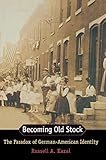Becoming Old Stock : The Paradox of German-American Identity / Russell A. Kazal.
Material type: TextPublisher: Princeton, NJ : Princeton University Press, [2022]Copyright date: ©2004Description: 1 online resource (404 p.) : 7 halftones. 5 line illus. 8 tablesContent type:
TextPublisher: Princeton, NJ : Princeton University Press, [2022]Copyright date: ©2004Description: 1 online resource (404 p.) : 7 halftones. 5 line illus. 8 tablesContent type: - 9780691223674
- Cultural pluralism -- United States -- Case studies
- Ethnicity -- United States -- Case studies
- German Americans -- Cultural assimilation -- Pennsylvania -- Philadelphia
- German Americans -- Pennsylvania -- Philadelphia -- Ethnic identity
- German Americans -- Pennsylvania -- Philadelphia -- Social conditions -- 20th century
- Immigrants -- Pennsylvania -- Philadelphia -- Social conditions -- 20th century
- Social classes -- Pennsylvania -- Philadelphia -- History -- 20th century
- White people -- Race identity -- Pennsylvania -- Philadelphia
- Whites -- Race identity -- Pennsylvania -- Philadelphia
- HISTORY / United States / General
- Alfredo, Waldemar
- American Legion
- Arbeiter Sängerbund
- Assing, Ottilie
- Barrett, James
- Bethel Lutheran Church
- Burstein, Alan
- Catholic Church
- Catholic Standard and Times
- Chinese immigrants
- Dillingham Commission
- Douglass, Frederick
- Fischler Sangerbund
- Franklin, Benjamin
- Gartner, Fred
- German American Bund
- German American League for Culture
- German Hospital
- Great Migration
- Hausvater
- Hexamer, Ernst
- Hughes, Charles Evans
- Inner Mission Society
- Jenkins, Philip
- Karpathen Saengerbund
- Kreimer, Hermann
- Kulturkampf
- Kunze, Gerhard
- Liberty Bond campaigns
- Lithuanians
- Midwest
- Mozart Harmonie
- New England
- Order Independent Americans
- Ostendorf, Berndt
- Pennsylvania Germans
- Plattdeutscher Verein
- Roediger, David
- advertisements
- amusement parks
- blackface minstrelsy
- brewing industry
- civil rights movement
- cultural pluralism
- department stores
- ethnic mixing
- mid-Atlantic region
- multiculturalism
- multiple identities
- occupations
- pluralism
- racial segregation
- 305.83/1074811 22
- F158.9.G3
- F158.9.G3 K39 2004eb
- online - DeGruyter
| Item type | Current library | Call number | URL | Status | Notes | Barcode | |
|---|---|---|---|---|---|---|---|
 eBook
eBook
|
Biblioteca "Angelicum" Pont. Univ. S.Tommaso d'Aquino Nuvola online | online - DeGruyter (Browse shelf(Opens below)) | Online access | Not for loan (Accesso limitato) | Accesso per gli utenti autorizzati / Access for authorized users | (dgr)9780691223674 |
Frontmatter -- Contents -- Illustrations -- Tables -- Acknowledgments -- Introduction -- PART ONE 1900 -- CHAPTER ONE German Philadelphia: A Social Portrait -- CHAPTER TWO Two Neighborhoods -- PART TWO Confronting Assimilation, 1900–1914 -- CHAPTER THREE The Gendered Crisis of the Vereinswesen -- CHAPTER FOUR Destinations: The Ambiguous Lure of Mass Commercial and Consumer Culture -- CHAPTER FIVE Destinations: Fractured Whiteness, “American” Identity, and the “Old Stock” Opening -- CHAPTER SIX Resisting Assimilation: Middle-Class and Working-Class Approaches -- PART THREE Storm, 1914–1919 -- CHAPTER SEVEN European War and Ethnic Mobilization -- CHAPTER EIGHT Intervention, the Anti-German Panic, and the Fall of Public Germanness -- PART FOUR Reshaping Identities in the 1920s -- CHAPTER NINE An Ethnicity Subdued -- CHAPTER TEN Changing Neighborhoods -- CHAPTER ELEVEN Middle-Class Germans: American Identity and the “Stock” of “Our Forefathers” -- CHAPTER TWELVE Workers and Catholics: Toward the “White Ethnic” -- CONCLUSION Pluralism, Nationalism, Race, and the Fate of German America -- APPENDIX The Neighborhood Census Samples -- Notes -- Index
restricted access online access with authorization star
http://purl.org/coar/access_right/c_16ec
More Americans trace their ancestry to Germany than to any other country. Arguably, German Americans form America's largest ethnic group. Yet they have a remarkably low profile today, reflecting a dramatic, twentieth-century retreat from German-American identity. In this age of multiculturalism, why have German Americans gone into ethnic eclipse--and where have they ended up? Becoming Old Stock represents the first in-depth exploration of that question. The book describes how German Philadelphians reinvented themselves in the early twentieth century, especially after World War I brought a nationwide anti-German backlash. Using quantitative methods, oral history, and a cultural analysis of written sources, the book explores how, by the 1920s, many middle-class and Lutheran residents had redefined themselves in "old-stock" terms--as "American" in opposition to southeastern European "new immigrants." It also examines working-class and Catholic Germans, who came to share a common identity with other European immigrants, but not with newly arrived black Southerners. Becoming Old Stock sheds light on the way German Americans used race, American nationalism, and mass culture to fashion new identities in place of ethnic ones. It is also an important contribution to the growing literature on racial identity among European Americans. In tracing the fate of one of America's largest ethnic groups, Becoming Old Stock challenges historians to rethink the phenomenon of ethnic assimilation and to explore its complex relationship to American pluralism.
Mode of access: Internet via World Wide Web.
In English.
Description based on online resource; title from PDF title page (publisher's Web site, viewed 29. Jul 2022)


